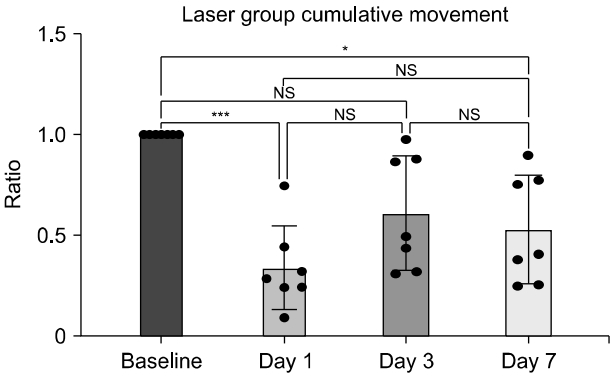Abstract
-
Objectives
- Inner ear ischemic animal models using photochemical reactions have been devised in various ways. Localized vascular ischemia occurs with 532-nm laser irradiation after systemic rose bengal injection, a known photothrombotic mechanism. The aim of this study is to evaluate a photothrombosis-induced vestibulopathy mimicking behavioral changes in the inner ear ischemia model.
-
Methods
- Seven-week-old male Spraque-Dawley rats were used. Animals were divided into three groups: control group (n=6), sham laser group (n=9), and laser group (n=9). To induce the photothrombosis, animals were injected with rose bengal into the femoral vein and then were irradiated with a 532-nm laser (175 mW for 900 seconds) via transtympanic membrane. To investigate the vestibulopathy after photothrombosis, the behavior tests (tail lift reflex test, air righting reflex test, rotarod test) were performed on the 1st, 3rd, and 7th days after surgery. Additionally, an open field test was conducted and analyzed using EthoVision XT (Noldus).
-
Results
- The laser group exhibited significant behavioral change to mimic vestibulopathy in all assessments. Inducing photothrombosis with rose bengal caused severe gait instability, which precluded rotarod testing. In the tail lift reflex test, the laser group displayed vestibular dysfunction with a lower angle formation compared to the control rats. During the open field test, the laser group exhibited reduced mobility, a condition that persisted in the laser groups for 7 days.
-
Conclusions
- Noninvasive laser irradiation using rose bengal and a 532-nm laser induces photothrombosis in the inner ear of animals, leading to the development of vestibulopathy mimicking imbalanced behavior.
-
Keywords: Inner ear; Ischemia; Lasers; Thrombosis; Imbalance
-
중심단어: 내이, 허혈, 레이저, 혈전증, 전정불안정
서 론
달팽이관 허혈 동물 모델을 만들고자 하는 시도는 이전부터 계속되어 왔다. Morawski 등[1]은 쥐를 이용한 동물 모델 연구에서 강한 소음에 노출하여 달팽이관 허혈을 일으킨 후 달팽이관의 혈류량을 측정하여 모델의 적합성을 확인하였으며, Olivetto 등[2]은 수술을 통해 총경동맥을 결찰함으로써 달팽이관으로 가는 혈류를 차단하여 달팽이관의 허혈성 변화를 유도하였다. 그러나 위와 같이 수술적인 방법으로 와우 혈류를 선택적으로 차단하여 허혈성 변화를 유도하는 동물 모델에서는 정밀하고 다소 시간이 많이 걸리는 수술이 요구되며, 술자에 따라 와우 혈류의 차단이 효과적이지 못해 동일한 결과를 재현하기에 어려움이 따를 수 있다.
이에 비침습적인 방식을 통한 와우 혈류 차단 방법이 다양하게 시도되어 왔으며, 그 중 광화학적 반응을 이용한 허혈성 난청 동물 모델이 여러가지 방법으로 고안되어왔다. 로즈 벵갈(rose bengal)은 적색의 염료로서, 주로 520–560 nm 파장의 녹색 빛과 반응하여 활성산소를 발생시킨다. 혈관 내에 로즈 벵갈을 주입한 뒤에 원하는 부위에 적절한 파장의 녹색 빛을 조사하면 혈관 내피의 손상이 일어나고 혈소판의 작용을 촉진하여 혈전을 생성하므로 원하는 부위에 부분적 허혈을 유도할 수 있다고 알려져 있다[3].
이에 본원에서는 로즈 벵갈을 대퇴정맥(femoral vein)에 주입한 후 고막을 통해(transtympanic) 레이저를 조사하여 비침습적인 허혈성 난청 동물 모델을 확립하는 시도를 하였다. 그 과정에서 동물 행동 관찰 시에 달팽이관 허혈이 유도된 군에서 전정 불안정과 유사한 행동학적 변화가 함께 유발되는 군이 있음을 확인하게 되었다[4].
이처럼 본 연구에서는 같은 방식으로 달팽이관 허혈이 유도된 군에서 동물 행동 실험을 통해서 전정 불안정을 시사할 수 있는 행동학적 변이가 나타남을 확인하여, 추후 전정병증(vestibulopathy) 연구에 유용한 동물 모델을 확립하고자 하였다.
대상 및 방법
1. 실험 동물
실험 동물은 정상 고막 및 청력 소견을 보이는 생후 7주령의 몸무게 200–220 g의 수컷 Spraque-Dawley (SD) 쥐를 사용하였다. 허혈 유도는 소동물용 흡입 마취기(JD-C107A, Jeung Do Bio & Plant Co., Ltd)로 동물을 마취한 후 진행하였다. 본 연구의 모든 동물 실험은 단국대학교 실험동물운영위원회가 제시하는 가이드라인 심의를 거친 후 승인을 받아 진행하였다(승인 번호: DKU-21-046).
2. 로즈 벵갈의 투여 방법
로즈 벵갈 분말(Sigma-Aldrich) 1 g을 1× phosphate buffered saline (Corning) 10 mL에 완전히 녹인 후 30 mg/kg 용량에 맞게 정맥 카테터(24 gauge, KOREAVACCINE)를 이용한 우측 대퇴정맥 내 정맥주사(intravenous injection)를 시행하였다.
3. Low Level Light 조사
광원으로는 532-nm diode-pumped solid-state (DPSS) laser (LRS-0532, Laserglow Technologies)를 사용하였으며, 레이저 세기는 SOLO 2 laser power meter (Newport)와 XLP12-1SH2-DO detector head (Newport)로 power를 측정하여 적용하였다. 광섬유(optic fiber)는 외이도를 통해 들어가 그 끝이 고막과 1 mm 이내로 거의 근접하도록 한 후 광조사를 시행하였다. 광조사는 로즈 벵갈 주입 후 5분이 경과한 시점부터 900초간 진행하였다(Fig. 1).
4. Behavior Test
Behavior test는 총 4가지 단계로 나누어 진행하였다.
1) Tail lift reflex test
쥐의 꼬리 끝을 잡아 지면에서 40 cm 정도 들어올린 뒤에 쥐의 움직임을 녹화하였다. 녹화 영상을 0.5배속으로 재생하여 코 지점-목 지점-꼬리 기점 사이의 각도가 가장 크게 측정되는 지점을 찾은 뒤에 각도를 측정하였다.
2) Air righting reflex test
쥐가 앙와위(supine position)가 되도록 실험자가 두 손으로 감싸 안고 지면에서 40 cm 정도 높이가 되도록 들어올린 뒤 갑자기 푹신한 쿠션 위에 떨어지도록 풀어주는 과정을 녹화하였다. 녹화 영상을 0.5배속으로 재생한 뒤 쥐가 쿠션 위로 떨어질 때의 position을 관찰하였으며, 1회의 평가 시 3차례 시행하였다.
3) Rotarod test
Rotarod treadmill (Cat. No. 7650, Ugo Basile S.R.L)을 이용하여 4 rpm에서 40 rpm까지 가속(accelerating speed)하는 방법으로 300초간 시행하는 동안 쥐가 막대(rod)에서 떨어지는 시간을 측정하였다. 1회의 평가 시 3차례 시도하여 이들의 평균 지속시간을 기록하였다.
4) Open field behavior recording
80×80×40 cm 규격의 open field를 제작하여 뚫려있는 천장을 통해 쥐를 풀어준 뒤 10분 동안 녹화하였다. 외부의 자극을 최소화하기 위해 암막을 이용해 open field의 전반을 감싸주었으며 녹화에 필요한 최소한의 불빛만을 허용하였다. 녹화 이후에 EthoVision XT 14 software (Noldus)를 이용하여 거리(distance), 속도(velocity), 가속도(acceleration), 누적 이동(cumulative movement), 천이(meander)를 분석하였다. 각 실험들 사이에 open field를 청소하였으며 모든 시도를 open field의 가운데에서 시작하였다[5].
5. 통계 분석
통계 분석은 GraphPad Prism (version 10.1.1 [270]; November 21, 2023) 프로그램을 사용하였다. 정규성 분포를 따르는 경우 분산분석 후 Tukey 검정을, 정규성 분포를 따르지 않는 경우는 Kruskal-Wallis test 후 Dunn’s multiple comparison 검정을 사용하였다. 통계적 유의 수준은 p값이 0.05 미만일 때로 정의하였다.
6. 실험 설계
총 24마리의 SD 쥐를 대상으로, 아무런 조작이 가해지지 않은 대조군 6마리, 로즈 벵갈 투여 이후 15분 동안 광섬유를 외이도에 거치만 해 놓은 샴 레이저군 9마리, 로즈 벵갈 투여 이후 532 nm 광조사를 시행한 레이저군 9마리로 나누어 실험을 진행하였다. 모든 쥐는 실험을 진행하기 전 5일 동안 조건화(conditioning)를 거쳤다. 조건화는 tail lift reflex test, air righting reflex test, rotarod test, open field behavior test를 포함하며, 실제 실험과 같은 환경에서 진행하여 실제 실험 시 적응하지 못하고 움직임이 감소하게 되는 변수를 줄이고자 하였다.
대조군은 5일간의 조건화 이후 추가적인 조치 없이 baseline, 1일, 3일, 7일째에 behavior test를 시행하였다. 샴 레이저군에서는 흡입 마취 하에 로즈 벵갈을 30 mg/kg 농도로 우측 대퇴정맥 혈관 내에 주입하였으며 5분 뒤 광섬유를 외이도에 15분간 거치하였다. 로즈 벵갈 주입 이후 1일, 3일, 7일째에 behavior test를 시행하였다. 레이저군에서는 마찬가지로 흡입 마취 하에 로즈 벵갈을 30 mg/kg의 농도로 우측 대퇴정맥 혈관 내에 주입하였으며 5분 뒤 532-nm DPSS laser를 175 mW의 세기로 1마리씩 고막에 15분간 조사하였다. 조사 후 1일, 3일, 7일째에 behavior test를 진행하였다.
결 과
샴 레이저군 9마리와 레이저군 9마리는 실험 첫째 날에 30 mg/kg의 농도로 로즈 벵갈을 우측 대퇴 정맥 혈관 내에 주입하였으며, 이중 샴 레이저군 1마리와 레이저군 2마리가 주입 당일 사망하였다. 이에 대조군 6마리를 합쳐 총 21마리에 대해 behavior test를 시행하게 되었다.
1. Tail Lift Reflex Test
로즈 벵갈 주입 전 baseline에서는 세 군 간의 결과 값에 통계적으로 유의미한 차이가 없었다. 로즈 벵갈 주입 이후에는 1일, 3일, 7일째의 결과 값이 레이저군에서 다른 두 군에 비해 통계적으로 유의미하게 감소했음을 확인할 수 있었다. 레이저군 내에서의 값을 비교해 보았을 때 1일, 3일, 7일째의 결과 값이 baseline에 비하여 통계적으로 유의미하게 감소했으며 1일, 3일, 7일째의 결과 값 사이에는 유의미한 차이가 없었다(Fig. 2).
2. Air Righting Reflex Test
대조군은 baseline부터 1일, 3일, 7일에 모두 지면에서 앙와위로 착지하는 모습이 관찰되었다. 샴 레이저군 또한 baseline, 1일, 3일, 7일 모두에서 앙와위로 착지하는 모습이 관찰되었다. 레이저군은 baseline에서 앙와위로 착지하는 모습이 관찰되었으나 1일, 3일, 7일에 낙하 시 수 차례 회전하며 앙와위로 착지하지 못하였고, 착지 이후에도 제자리에서 회전하는 모습이 관찰되었다.
3. Rotarod Test
모든 쥐들은 5일간의 조건화를 통하여 rotarod test에 적응을 하여 baseline에서 세 군의 기록은 평균적으로 300초에 가까웠고 세 군 간의 통계적인 차이는 없었다. 대조군과 샴 레이저군의 기록은 baseline과 비교하였을 때 1일, 3일, 7일에서 기록이 다소 감소하였으나 통계적으로 유의한 차이를 보이지는 않았다. 레이저군의 쥐는 1일째부터 막대 위에서 균형을 잡지 못하고 추락하는 모습을 보였고, 수 차례의 시도에도 같은 결과임을 확인하였다. 이는 3일, 7일째에도 회복되지 않아 rotarod test의 결과는 0초로 간주하였다. Rotarod test 결과는 레이저군의 값이 모두 0으로 정규분포가 아니므로 Kruskal-Walis 방법을 이용하여 분석하였다. 레이저군의 기록은 1일, 3일, 7일째 모두 0초로, 대조군과 샴 레이저군 모두의 기록과 통계적으로 유의미한 차이를 보였다. 레이저군 내에서도 baseline과 1일, 3일, 7일째의 기록은 통계적으로 유의미한 차이를 보였다(Fig. 3).
4. Open Field Behavior Test
모든 쥐들은 5일간의 조건화를 거친 후 open field behavior test를 시행하였으며 baseline에서 세 군의 각각의 변수들에 대한 결과 값은 차이가 없었다.
거리는 10분 동안 움직인 총 거리를 나타내며 쥐의 머리의 움직임을 나타내는 코 지점에서 측정되었다. 대조군에서 거리는 1일, 3일 7일의 기록이 baseline과 비교하였을 때 큰 차이를 보이지 않았다. 샴 레이저군 또한 1일, 3일, 7일의 기록이 통계적으로 유의미한 차이를 보이지 않았다. 레이저군에서는 1일째에 baseline에 비하여 기록이 감소하고 3일, 7일째에 점점 기록이 증가하는 모습을 보였으나 이 또한 baseline과 비교하였을 때 모든 시행일에서 통계적으로 유의미한 차이를 보이지는 않았다. 실험일 별로 각 군의 결과를 비교해 보았을 때 1일째에 레이저군의 결과 값이 대조군에 비해 통계적으로 유의미하게 감소하였고, 3일째에는 레이저군의 결과 값이 샴 레이저군에 비해 유의미하게 감소하였다. 7일째에 세 군의 결과 값에 유의미한 차이는 보이지 않았다(Fig. 4). 속도와 가속도 또한 쥐의 코 지점에서 측정되었으며, 속도의 경우 각 군과 시행일 별로 결과 값의 차이는 보였으나 통계적으로 유의미한 차이를 보이지는 않았다(Fig. 5). 하지만 가속도의 경우 레이저군 내 시간별 차이를 보였고, 7일째에 baseline에 비해 유의한 감소를 보였다(Fig. 6).
누적 이동은 움직인 거리와는 다른 변수로, 전체 시간 중 피사체의 활동성에 관련된 변수이다. 분석 과정 중 EthoVision XT에서 “moving”이라고 판단하는 상태의 시간을 의미하는데, “moving”은 쥐가 움직이기 시작하여 평균 속도(mean velocity)가 2.00 cm/초 이상인 순간부터 1.75 cm/초 아래로 떨어지기까지의 시간으로 이를 통해 전체 시간 중 활동성이 있는 시간을 수치화하였다. 대조군과 샴 레이저군에서는 전체 시행일에서 큰 차이를 보이지 않았으나, 레이저군에서는 1일, 7일째에서 baseline과 비교하였을 때 유의미하게 결과 값이 감소하였으며 3일째는 baseline 과 비교하였을 때 통계적으로 유의미한 차이를 보이지 않았다(Fig. 7).
천이는 피사체의 이동되는 거리에 대한 피사체의 이동 방향 변화와 궤적이 얼마나 복잡한지를 나타낸다. 모든 군에서 baseline과 1일, 3일, 7일째의 천이 값이 큰 차이를 보이지 않았으며 통계적으로 유의하지 않았다.
고 찰
전정기능 장애를 유발하기 위하여 다양한 동물 실험 모델이 개발되었으며, 더 비침습적인 방법을 고안하여 연구를 하는 데 용이하게 했다. Yamaoka 등[6]은 ultrasonicator와 sodium arsanilate를 이용하여 전정기능 장애를 유발하였으며 이를 balance test, swimming test, air righting reflex test를 통해 평가하였다. Cassel 등[7]은 kainic acid를 고막 내 주입(intratympanic injection)하여 쥐의 전정기능 장애를 유발하였고 general vestibular sign, tail lift test를 통해 일측성 전정손상군에서 전정기능 장애가 성공적으로 유도되는 것을 관찰하였다. Negishi-Oshino 등[8]은 intradialytic parenteral nutrition (IDPN; 3’,3’-iminodipropionitrile)을 구강 내 주입하여 전정기능 장애 유발을 시도하였고, rotarod test, beam crossing test, air righting reflex test를 통해 이 전정기능 장애 모델의 효용성을 증명하였다.
본 연구에서는 전정기능 이상 여부를 평가하기 위한 방법으로 tail lift reflex test, air righting reflex test, rotarod test, open field behavior test를 사용하였다. Maroto 등[9]은 IDPN 복강 내 주입을 통하여 전정 유모 세포의 손실을 유도하였으며 tail lift reflex test, air righting reflex test의 방법을 통해 행동학적 분석을 시행하였다. 이후 조직학적 결과를 통해 전정 유모 세포의 손실과 위 두 가지 test 간의 연관성에 대해 설명하였다. Rastoldo 등[5]은 일측 전정신경절단술(unilateral vestibular neurectomy)을 통해 일측성 전정병증을 유도하였으며 이를 rotarod test, EthoVision XT를 이용한 open field behavior test를 통하여 분석하였다. 그 결과 일측 전정신경절단술을 시행한 군에서 거리, 속도, 가속도가 대조군에 비해 1일–3일에서 유의미하게 감소하였으며 이후 30일째까지 대조군과 비슷한 수준으로 회복되는 것을 관찰하였다. 이들은 이를 통해 전정병증 유도 이후 시간이 지남에 따라 전정 보상 과정을 통한 회복이 일어나는 것을 설명하였다.
광화학 반응을 이용해 혈관 내 허혈을 일으키는 방법은 전정기능 장애를 유발하는 모델뿐 아니라 두개 내 혈관 허혈을 이용하는 뇌졸증 모델 등의 분야에서 다양하게 연구해 왔다. 본 연구에서는 내이 허혈을 유도하기 위해 로즈 벵갈을 대퇴정맥 혈관 내에 주입한 뒤 DPSS laser를 조사하여 나타나는 광화학 반응을 이용하였다. 광화학 반응을 통해 혈관 허혈을 일으킬 수 있는 다른 물질로는 erythrosin B가 있는데, Bergeron [10]은 erythrosin B를 주입한 뒤 광조사를 통해 대뇌 피질 경색을 일으키는 데 성공하였다. 그는 같은 조건에서 로즈 벵갈을 주입한 뒤 광조사를 통해 대뇌 피질 경색을 유발하는 실험을 하였는데, 로즈 벵갈을 이용했을 때 경색의 부위가 더 광범위하게 나타났기 때문에 광화학 반응을 통한 모델링에서 로즈 벵갈의 사용을 권장하였다.
본 연구에서 전정 불안정 유사 행동을 유도해낸 방법을 앞서 소개된 방법들과 비교할 때, 로즈 벵갈을 대퇴정맥 내 주입하기 위한 수술적 조작과 DPSS laser를 조사하는 시간이 추가로 필요하여 실험 시간이 더 소요되므로 술자의 능숙도에 따라 동일한 조건을 유도하기 어려울 수 있다는 단점이 있다. 또한 본 연구는 총 21 마리의 SD 쥐를 대상으로 실험을 진행하였으므로, 적은 표본 수로 인해 재현성에 한계가 있을 수 있다. 추후 충분한 표본 수로 추가 실험을 진행하여 모델의 재현성을 확인하는 과정이 필요할 것이다. 레이저군에서 행동 불안정을 유발하는 데에는 성공하였으나 그 정도가 너무 심하여 rotarod test를 전혀 시행하지 못할 정도였다. 추후 532-nm DPSS laser의 조사 세기와 시간, 고막 및 와우 내 투과율에 대한 추가적인 연구를 통해 보다 효율적인 전정병증 모델을 만들어내야 할 것으로 생각된다. 선행 연구에서 로즈 벵갈 주입 5분 뒤 175-mW laser를 고막을 통해 15분간 광조사한 뒤 청성뇌간반응(auditory brainstem response, ABR) 검사를 시행했을 때 1일 뒤 모든 주파수에서 70 dB 이상의 청력 저하를 확인하였으며, 10일 뒤 검사에서도 60 dB 이상의 청력 저하가 남아있음을 확인하였다. 따라서 본 연구에서 ABR 검사를 시행할 때도 비슷한 양상의 청력 저하가 확인될 것으로 생각되며, 이러한 청력 저하가 동반된다면 내이 두 기관의 허혈이 모두 진행되는 것이라고 생각해 볼 수 있다[4].
결 론
본 연구에서는 비침습적인 방법인 로즈 벵갈의 정맥 내 주입과 DPSS laser 조사를 이용하여 일측성 전정 불안정 유사 행동학적 변화를 유발해 냈으며, 이와 같은 광화학 반응을 추후 전정병증 모델을 유발하는 연구에 활용할 수 있으리라 기대한다.
ARTICLE INFORMATION
-
이해관계(CONFLICT OF INTEREST)
저자들은 이 논문과 관련하여 이해관계의 충돌이 없음을 명시합니다.
-
연구 지원(FUNDING/SUPPORT)
이 논문은 2023년도 과학기술정보통신부의 재원으로 한국연구재단의 지원을 받아 수행된 해외연구기관 유치사업 연구이고(NRF-2023K1A4A3A02057280), 2022년 과학기술정보통신부의 중견연구과제 재원으로 한국연구재단의 지원을 받아 수행되었습니다(NRF-2022R1A2C2006358).
-
저자 기여(AUTHOR CONTRIBUTIONS)
Conceptualization: JYJ, MYL, JEC, SYC, JHL; Data curation, Funding acquisition, Project administration, Validation: JYJ, MYL, JEC; Formal analysis: SYC, JHL, JPC, NTC; Investigation, Methodology: JYJ, MYL, JEC, MSS; Supervision: SYC, JHL; Visualization: MSS, SYC, JHL, JPC, NTC; Writing–original draft: MSS; Writing–review & editing: All authors.
All authors read and approved the final manuscript.
Fig. 1.Basic experiment setting of transcanal irradiation of 532-nm diode-pumped solid-state laser. (A) A stereotactic device was used to fix the tip of laser. (B) The tip of laser was placed in front of the tympanic membrane.
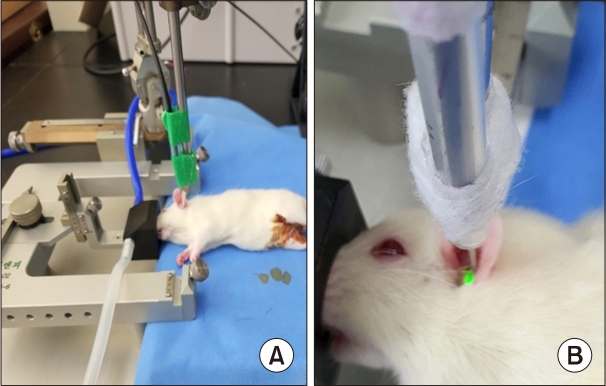
Fig. 2.Tail lift reflex test. The recorded video was reproduced at 0.5 speed, and the angle was measured between the nose point–neck point–and base of the tail point. (A) The control group and sham laser group were relatively calm and formed an obtuse angle. (B) The laser group formed an acute angle. (C) At all experiment days, the angle formation of the laser group was smaller than that of the other two groups, and this difference was statistically significant. (D) In the laser group, the angle formations on days 1, 3, and 7 are statistically smaller than the baseline. NS, not significant. ****p<0.0001.
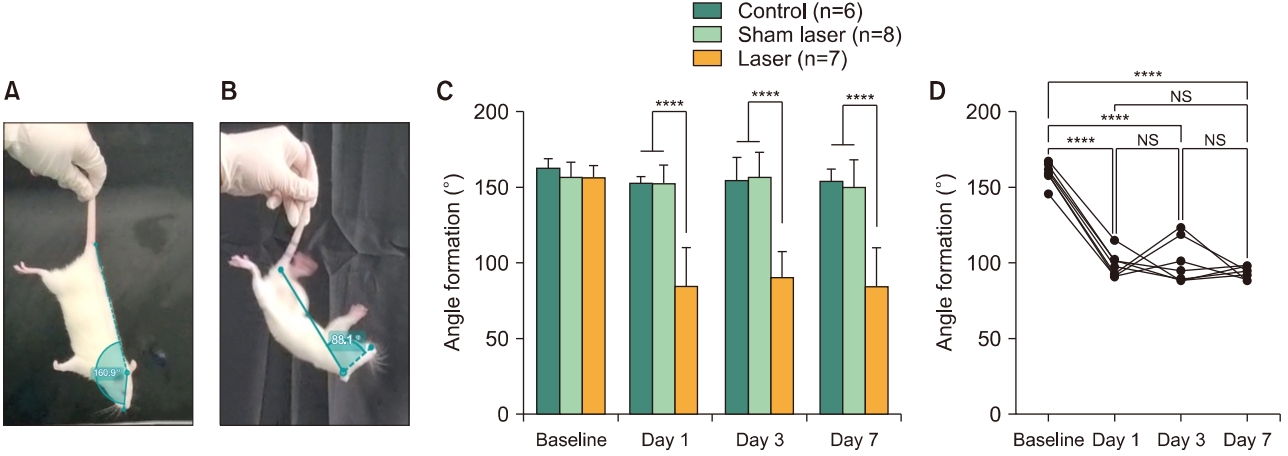
Fig. 3.Rotarod test results. (A) The control rats were able to hold on to the rotarod test for more than 300 seconds on all days. (B) The records of the laser group were all 0 seconds, showing a statistically significant difference from the records of both the control group and the sham laser group. (C) In the laser group, the results on days 1, 3, and 7 are statistically smaller than the baseline. NS, not significant. ****p<0.0001.
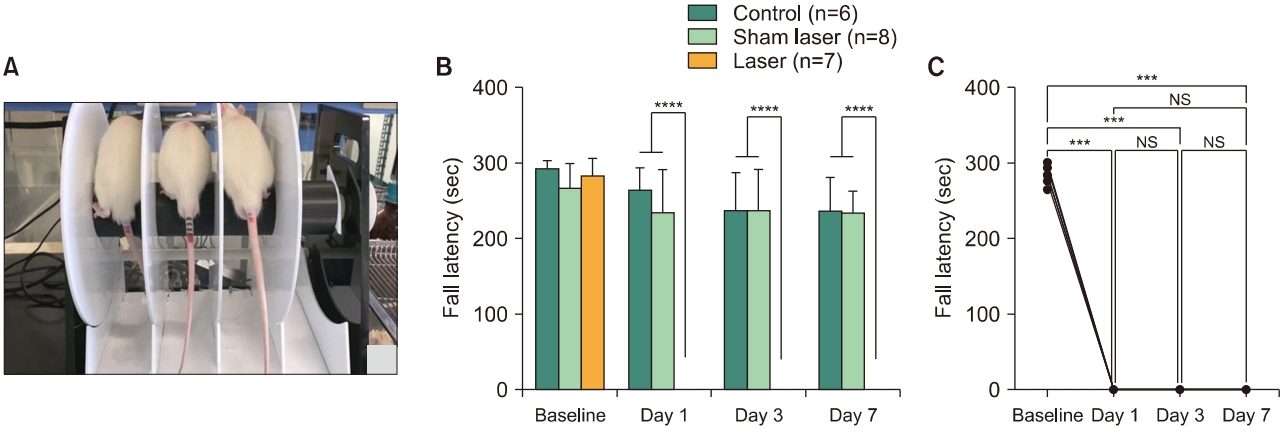
Fig. 4.Comparison of distance results of the open field behavior test analyzed by EthoVision XT (Noldus). (A) Total distance of each group. The result of the laser group was decreased compared with baseline, but there was no statistical significance. (B) Day 1 result of the distance. Total distance of the laser group was significantly smaller than the result of the control group. (C) Day 3 result of the distance. The result of the laser group was significantly decreased compared with the sham laser group result. (D) Day 7 results of distance. There was no statistical difference in each group. RR, relative ratio; NS, not significant. *p<0.05.
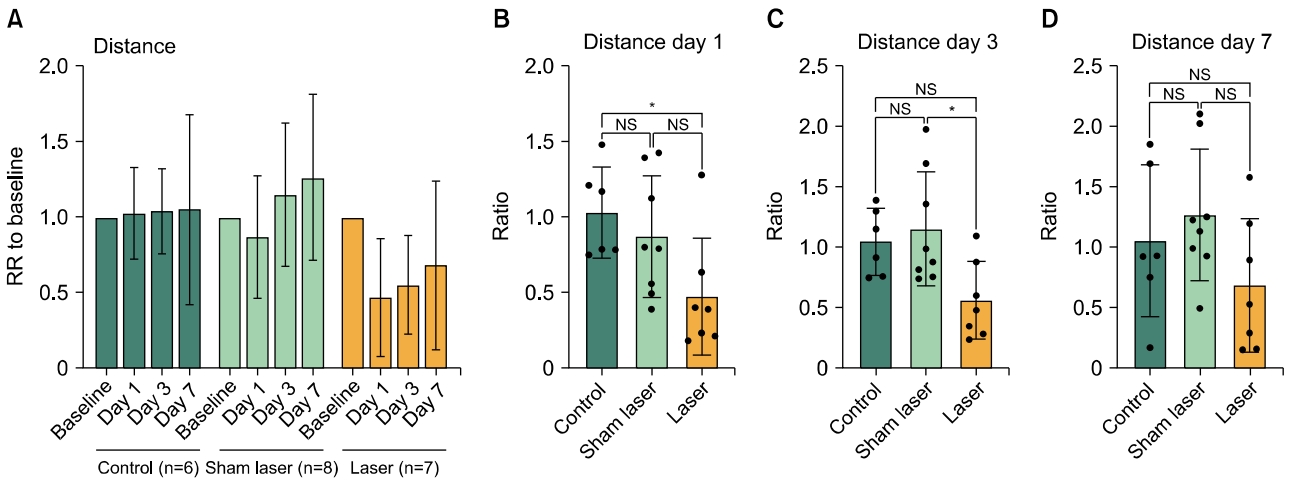
Fig. 5.Comparison of velocity results of the open field behavior test analyzed by EthoVision XT (Noldus). On all days, the results of the entire group were not statistically significant from the baseline of each group. RR, relative ratio.
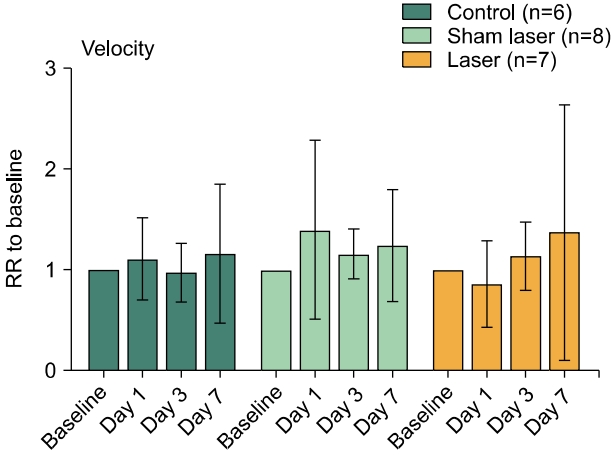
Fig. 6.Comparison of acceleration results of the open field behavior test in laser treatment group analyzed by EthoVision XT (Noldus). The result on day 7 was significantly decreased compared with that of baseline. NS, not significant. **p<0.05.
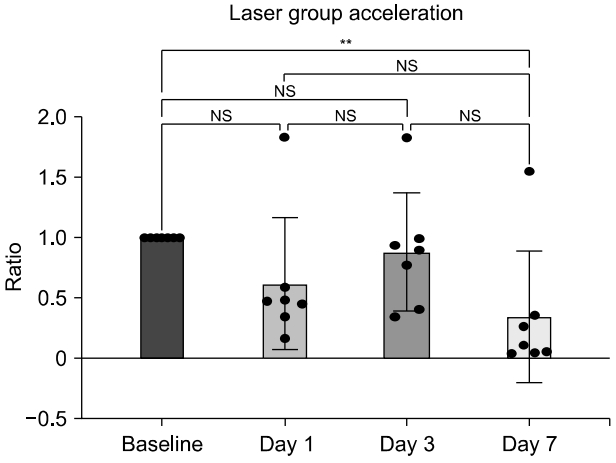
Fig. 7.Comparison of cumulative movement (moving) results of the open field behavior test in laser treatment group analyzed by EthoVision XT (Noldus). ‘Cumulative movement’ represents the mobility of the rats in the open field behavior test. The results on days 1 and 7 were significantly decreased compared with that of baseline. The result on day 3 was decreased than baseline, but there was no statistical significance. NS, not significant. *p<0.05.

REFERENCES
- 1. Morawski K, Telischi FF, Bohorquez J, Niemczyk K. Preventing hearing damage using topical dexamethasone during reversible cochlear ischemia: an animal model. Otol Neurotol 2009;30:851–7.PubMed
- 2. Olivetto E, Simoni E, Guaran V, Astolfi L, Martini A. Sensorineural hearing loss and ischemic injury: development of animal models to assess vascular and oxidative effects. Hear Res 2015;327:58–68.ArticlePubMed
- 3. Westrick RJ, Winn ME, Eitzman DT. Murine models of vascular thrombosis (Eitzman series). Arterioscler Thromb Vasc Biol 2007;27:2079–93.PubMed
- 4. Choi JH, Choi JE, Chang SY, Lee MY, Jung JY. Establishment of a non-invasive ischemic hearing loss animal model using the rose bengal dye and 532 nm low-level light energy (photo-thrombosis) in Republic of Korea: animal study. 2022;11:236–43.Article
- 5. Rastoldo G, Marouane E, El Mahmoudi N, Péricat D, Bourdet A, Timon-D avid E, et al. Quantitative evaluation of a new posturo-locomotor phenotype in a rodent model of acute unilateral vestibulopathy. Front Neurol 2020;11:505. ArticlePubMedPMC
- 6. Yamaoka Y, Abe C, Morita H. Comparison among ultrasonic, electrical apparatus, and toxic chemicals for vestibular lesion in mice. J Neurosci Methods 2018;295:58–67.ArticlePubMed
- 7. Cassel R, Wiener-Vacher S, El Ahmadi A, Tighilet B, Chabbert C. Reduced balance restoration capacities following unilateral vestibular insult in elderly mice. Front Neurol 2018;9:462. ArticlePubMedPMC
- 8. Negishi-Oshino R, Ohgami N, He T, Ohgami K, Li X, Kato M. cVEMP correlated with imbalance in a mouse model of vestibular disorder. Environ Health Prev Med 2019;24:39. ArticlePubMedPMCPDF
- 9. Maroto AF, Barrallo-Gimeno A, Llorens J. Relationship between vestibular hair cell loss and deficits in two anti-gravity reflexes in the rat. Hear Res 2021;410:108336. ArticlePubMed
- 10. Bergeron M. Inducing photochemical cortical lesions in rat brain. Curr Protoc Neurosci 2003;Chapter 9:Unit 9.16. ArticlePubMedPDF
Citations
Citations to this article as recorded by












 KBS
KBS
 PubReader
PubReader ePub Link
ePub Link Cite
Cite





